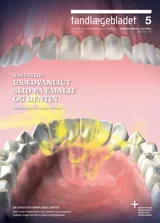Rekonstruktion efter mandibulært osteosarkom
Baggrund – Osteosarkom er en malign knoglesygdom med en femårs overlevelsesrate på 65 %. Kirurgi er den vigtigste behandlingsmodalitet. Patienttilfælde – En 23-årig mand blev i 2002 henvist til Tand-Mund-Kæbe-kirurgisk Klinik, Rigshospitalet, med en vævsnydannelse, der blev diagnosticeret som osteosarkom regio 3– ad –3. Patienten fik efter resektion af primær tumor rekonstrueret mandiblen med småpartikulært kortikospongiøst transplantat fra crista iliaca. Dental rehabilitering blev opnået ved implantatforankrede faste tanderstatninger. Fem år efter resektion, transplantation og indsættelse af implantatforankret protetik var patienten recidivfri og velbefindende. Konklusion – Rekonstruktion af mandiblen kan udføres forudsigeligt med autolog knogletransplantation. Ved avaskulært knogletransplantat, som i beskrevne tilfælde er udtaget fra crista iliaca, er det muligt at genopbygge mandiblen i fuld højde og med en kæberelation, som er velegnet til senere implantatbaseret protetik med tilfredsstillende kosmetisk og funktionelt udfald.
Reconstruction after mandibular osteosarcoma
Background – Osteosarcoma is a malignant bone disease with a 5-year survival rate of 65 %. Radical surgery is first choice of treatment. Case study – A 23-year old man was referred to the Department of Oral and Maxillofacial Surgery, Copenhagen University Hospital (Rigshospitalet) for diagnosis of a tissue neoformation at the anterior part of the mandible. Biopsy showed osteosarcoma. After resection of the primary tumour, the patient was reconstructed with particulate cortico-cancellous bone from the iliac crest. Five years after resection, reconstruction, and dental rehabilitation with implant-supported fixed prostheses, the patient exhibited well-being and was without recurrence of the disease. Conclusion – Reconstruction of the mandible can be performed with autologous bone grafting. With avascular bone graft, as in the described case, taken from the iliac crest, it is possible to rebuild the mandible to the full height and with a jaw relation that is suitable for rehabilitation, with an implant supported prosthesis with a positive cosmetic and functional outcome.


